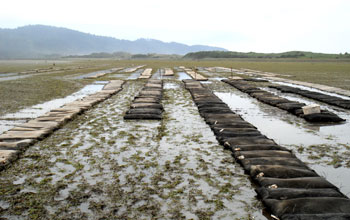NSF Press Release 13-102 — Ocean acidification inhibits shell formation, but interventions at hatcheries may offset some effects, scientists find

Research site in Netarts Bay, Oregon, at low tide; rows of bags contain seed oysters. Credit: R. Mabardy, OSU
June 11, 2013
In World Oceans Month, there’s mixed news for the Pacific Northwest oyster industry.
For the past several years, it has struggled with significant losses due to ocean acidification. Oyster larvae have had mortality rates high enough to render production no longer economically feasible.
Now a new study documents why oysters appear so sensitive to increasing acidity, but also offers some hope for the future.
It isn’t necessarily a case of acidic water dissolving the oysters’ shells, scientists say. It’s water high in carbon dioxide altering shell formation rates, energy usage and, ultimately, the growth and survival of young oysters.
“The failure of oyster seed production in Northwest Pacific coastal waters is one of the most graphic examples of ocean acidification effects on important commercial shellfish,” said Dave Garrison, program director in the National Science Foundation’s (NSF) Division of Ocean Sciences.
NSF funded the study through its Ocean Acidification Program, part of NSF’s Science, Engineering and Education for Sustainability programs.
“This research is among the first to identify the links among organism physiology, ocean carbonate chemistry and oyster seed mortality,” said Garrison.
Results of the study are online in the journal Geophysical Research Letters, published by the American Geophysical Union.
“From the time eggs are fertilized, Pacific oyster larvae precipitate roughly 90 percent of their body weight as a calcium carbonate shell within 48 hours,” said George Waldbusser, an Oregon State University marine ecologist and lead author of the paper.
“Young oysters rely solely on the energy they derive from the egg because they have not yet developed feeding organs.”
During exposure to increasing carbon dioxide in acidified water, however, it becomes more energetically expensive for organisms like oysters to build shells.
Adult oysters and other bivalves may grow more slowly when exposed to rising carbon dioxide levels. But larvae in the first two days of life do not have the luxury of delayed growth.
“They must build their first shell quickly on a limited amount of energy–and along with the shell comes the organ to capture external food,” said Waldbusser.
“It becomes a death race of sorts. Can the oyster build its shell quickly enough to allow its feeding mechanism to develop before it runs out of energy from the egg?”
Media Contacts
Cheryl Dybas, NSF (703) 292-7734 cdybas@nsf.gov
Mark Floyd, Oregon State University (541) 737-0788 mark.floyd@oregonstate.edu
Peter Weiss, American Geophysical Union (202) 777-7507 pweiss@agu.org
Related Websites
NSF News Release: Ocean Acidification Linked With Larval Oyster Failure in Hatcheries:http://www.nsf.gov/news/news_summ.jsp?cntn_id=123822
NSF Science, Engineering and Education for Sustainability Programs: http://www.nsf.gov/sees
NSF Publication: Discoveries in Sustainability: http://www.nsf.gov/pubs/2012/disco12001/disco12001.pdf

The National Science Foundation (NSF) is an independent federal agency that supports fundamental research and education across all fields of science and engineering. In fiscal year (FY) 2012, its budget was $7.0 billion. NSF funds reach all 50 states through grants to nearly 2,000 colleges, universities and other institutions. Each year, NSF receives about 50,000 competitive requests for funding, and makes about 11,500 new funding awards. NSF also awards about $593 million in professional and service contracts yearly.
National Science Foundation, 11 June 2013. Press release.